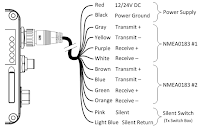Raymarine AXIOM and NMEA0183

Updated 2021-07-24 !
Some solutions
- Pick N1 data from the AIS
- NMEA 2000, N2 to N1 konverter
- SeaTalk NG, NG to N1 konverter
NMEA 2000 and SeaTalk NG
These "standards" share the same protocol but have different connectors
Baud rate
Baud rate
The standard N1 baud rate, data communication transfer rate, for VHF:s are 4 800 which differs from the baud rate which AIS signals is transfered, 38 400.
 Input from AIS
Input from AIS
Many AIS receivers/transducers have an N1 port which can be used. Below 2 use cases.
Camino 108W
In one case I had a Camino 108W AIS, with N2 connector, which also had N1 output. The N1 #1 output, gray and yellow, was connected to the VHF N1 input and the Camino 108 configured to output data at baud rate 4800.Raymarine AIS 350 and AIS 650
Another case was the AIS 650 with circuit according to the picture at the right. There are dubble N1 ports which also can act as a simple N1 multiplexer. The hard thing with this case was that the pre configured 4800 port was defect. So using the ProAIS2 app I changed the baud rate, on the other port, to 4800 and then it worked.
Using ST to ST NG converter
Using a ST to ST NG converter according to this article is another way to solve it
Using a Yacht Devices converter
The YDNR-02 is my favorite and could also solve a more complex problem with both the old Raymarine Seatalk/ST 1 bus, N1 and N2 data. As an add on You will also get all the NMEA data available via Wifi.
Using a ST to ST NG converter according to this article is another way to solve it
Using a Yacht Devices converter
The YDNR-02 is my favorite and could also solve a more complex problem with both the old Raymarine Seatalk/ST 1 bus, N1 and N2 data. As an add on You will also get all the NMEA data available via Wifi.











Comments
Post a Comment
Feel free to leave a comment ! ... but due to a lot of spam comments I have to moderate them. Will reply ASAP !